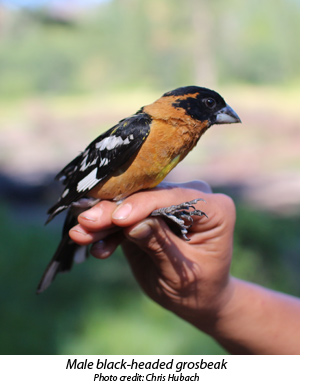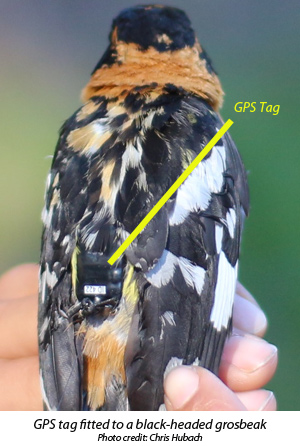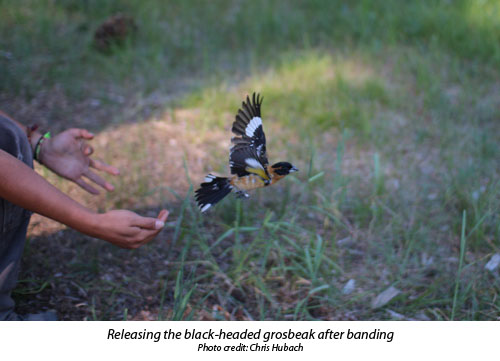 A wide diversity of bird calls ring loud and clear every morning and there is a constant hubbub of birds flying by, delivering food to mates and hungry chicks. We have recently passed the summer solstice and the longest day of the year, but the bird researchers with the Monitoring Avian Productivity and Survivorship (MAPS) project are already midway through their summer season. This crew works in 6 meadow locations in Yosemite, netting song birds and recording data about the size and condition of the birds captured. Birds are fitted with a small aluminum ring on their ankle with a unique number etched into it, and then the birds are released back to their territories and nests. Yosemite National Park has participated in banding birds for a quarter century, and its stations are the second oldest in the country. This long data set enables scientists to learn about songbird trends and demographics.
A wide diversity of bird calls ring loud and clear every morning and there is a constant hubbub of birds flying by, delivering food to mates and hungry chicks. We have recently passed the summer solstice and the longest day of the year, but the bird researchers with the Monitoring Avian Productivity and Survivorship (MAPS) project are already midway through their summer season. This crew works in 6 meadow locations in Yosemite, netting song birds and recording data about the size and condition of the birds captured. Birds are fitted with a small aluminum ring on their ankle with a unique number etched into it, and then the birds are released back to their territories and nests. Yosemite National Park has participated in banding birds for a quarter century, and its stations are the second oldest in the country. This long data set enables scientists to learn about songbird trends and demographics.
As of June 14, 2014, the bird banders had netted a total of 371 birds in all six meadow locations. 236 of these birds were new (not previously banded), and 110 were recaptured birds already sporting leg bands. A small number of birds escape or cannot be banded.
I had the opportunity to observe the bird banding and mist nets in Hodgdon Meadow on June 12, and I spoke with Todd Alleger from The Institute for Bird Populations about what trends he is noticing so far. He said that of 35 species caught in this location, some birds stand out as unusual visitors such as the fox sparrow, evening grosbeak, and calliope hummingbird. They have also seen more Lawrence’s goldfinches, which tend to follow drought. Hatch year birds are starting to appear, including dark-eyed juncos and orange-crowned warblers. While it is too early to analyze this year’s data, it will be interesting to see what effects the Rim Fire had on Hodgdon Meadow’s birds, as well as the very dry winter and low snow pack.


New this year is a project to fit tiny GPS tags onto ten black-headed grosbeaks. The GPS data that is recorded will show us these birds’ migratory routes and where they spend the winter. The goal is to recapture these birds when they return to Yosemite, and remove the transmitters. With more information about the birds’ lives away from Yosemite, scientists and conservationists can analyze trends internationally, perhaps leading to more protection for this songbird and others during migration and on the wintering grounds.

There is much to be learned from the birds, and Yosemite’s avian monitoring projects are hugely important. Stay tuned for more reports this summer season!

Interested in a summary for this year's research? (Check out Part 3 of this series).
